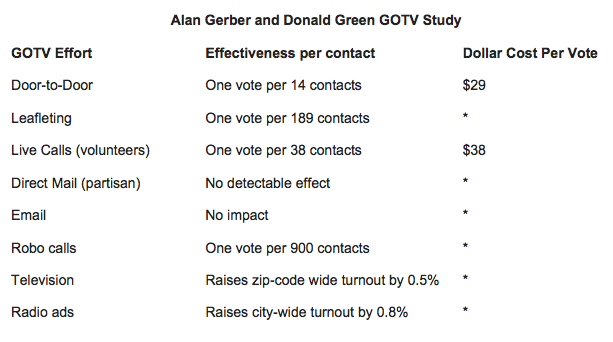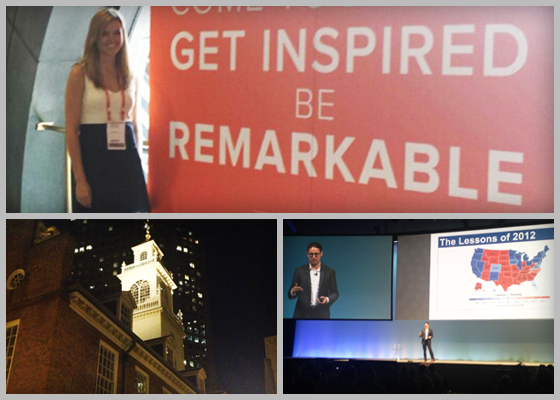Ten years ago you had 12 minute attention spans to work with in attracting voters online. Today, you have 8 seconds. Whether we like it or not, social media is the new currency, and unless we adjust accordingly, we’ll be broke.
If you’ve already made adjustments and have an online presence, then you’re doing much better than many of your colleagues. But having a web presence alone was cutting edge in the ’90s. Welcome to 2013.
With the competition from the Left and the advancements in digital campaigning and political technology, including data-driven analytics, testing, and optimization, it’s not enough to simply exist online.
Gain an edge by utilizing the latest technology – offline by turning data into votes on the ground – and online using tools and digital strategies to capture the attention of your voters and empower your offline campaign.
Here are five practical guidelines to grabbing attention and keeping it:
1. Position your important information strategically
The average page visit lasts a little less than a minute, so make sure that your viewer’s eye is drawn to the most crucial part of your campaign from the moment he or she access the site. For example, if your mission statement is what you think will empower supporters, place it in large text at the top. And as always, test it out. Is your important information placed strategically? Use online tools such as Usability Hub’s Five Second Test, which gives users the ability to test sections of their site against a random audience.
2. Avoid clutter
Everyone is tempted to put all their information on that first page, but don’t do it. Rather than overwhelm your audience with cluttered content, simplify your home page and make it interesting enough so that people will want to click through to your more meaty platform. Today, with the dominance of technology and social media in every sphere, including politics, it is well worth the time and funds to hire a professional web designer. This will ensure that your layout highlights the important information without losing anything crucial and keeps the reader on your website.
3. Ensure that your website is running properly
This may seem simple, studies show that if a website takes longer than 3 seconds to load, 40% of users will abandon the page. The faster your site loads the better your chances that people will actually read your website, let alone click through it. There are online tools that you can download to ensure your website reaches its maximum viewing potential.
4. Connect to your other social media networks
Online campaigning doesn’t stop with the website. Facebook is a must for the modern campaign. We think Twitter is too. Think of social networks as different social functions. The more events you go to, the more people you meet, and the more you get the word out, the more reach you will have for your ideas. A website is the perfect place to advertise your presence on other social networks. Use it to interact with your audience and broadened your reach.
5. Analyze and improve
Here at Voter Gravity we live and breath data and analytics. Never implement a suggestion without testing and analyzing if it actually works for you. Only by looking back and determining who has visited your site, clicked through links, commented on posts, used certain search terms, etc. can you craft your digital strategy into something truly successful. If the numbers don’t add up, then make improvements. Google Analytics recently released a report about how the Obama 2012 campaign took advantage of Google Analytic tools to gain an upper edge: “Having quick and easy access to actionable data was essential for President Obama’s data-driven re-election campaign in 2012…. Early on, they turned to Google Analytics to help the web, email, and ads teams understand what motivated new supporters to become more vocal advocates and regular donors over time. The team tested various secondary calls-to-action after a visitor’s initial signup or donation to encourage further involvement with the campaign.” Check out the full case study here.

 Now the study notes that the * means “Cost effectiveness is not calculated for tactics that are not proven to raise turnout” and that “door-to-door canvassing is talking to targeted voter, for phone calls, talking to targeted voter.” So robo calls, emails, and direct mail have no real impact for GOTV, and it should be noted that television and radio raise turnout by less than a point. That is not even targeted GOTV. It just raises turnout generally, not necessarily among a campaign’s targeted voters.
Now the study notes that the * means “Cost effectiveness is not calculated for tactics that are not proven to raise turnout” and that “door-to-door canvassing is talking to targeted voter, for phone calls, talking to targeted voter.” So robo calls, emails, and direct mail have no real impact for GOTV, and it should be noted that television and radio raise turnout by less than a point. That is not even targeted GOTV. It just raises turnout generally, not necessarily among a campaign’s targeted voters.